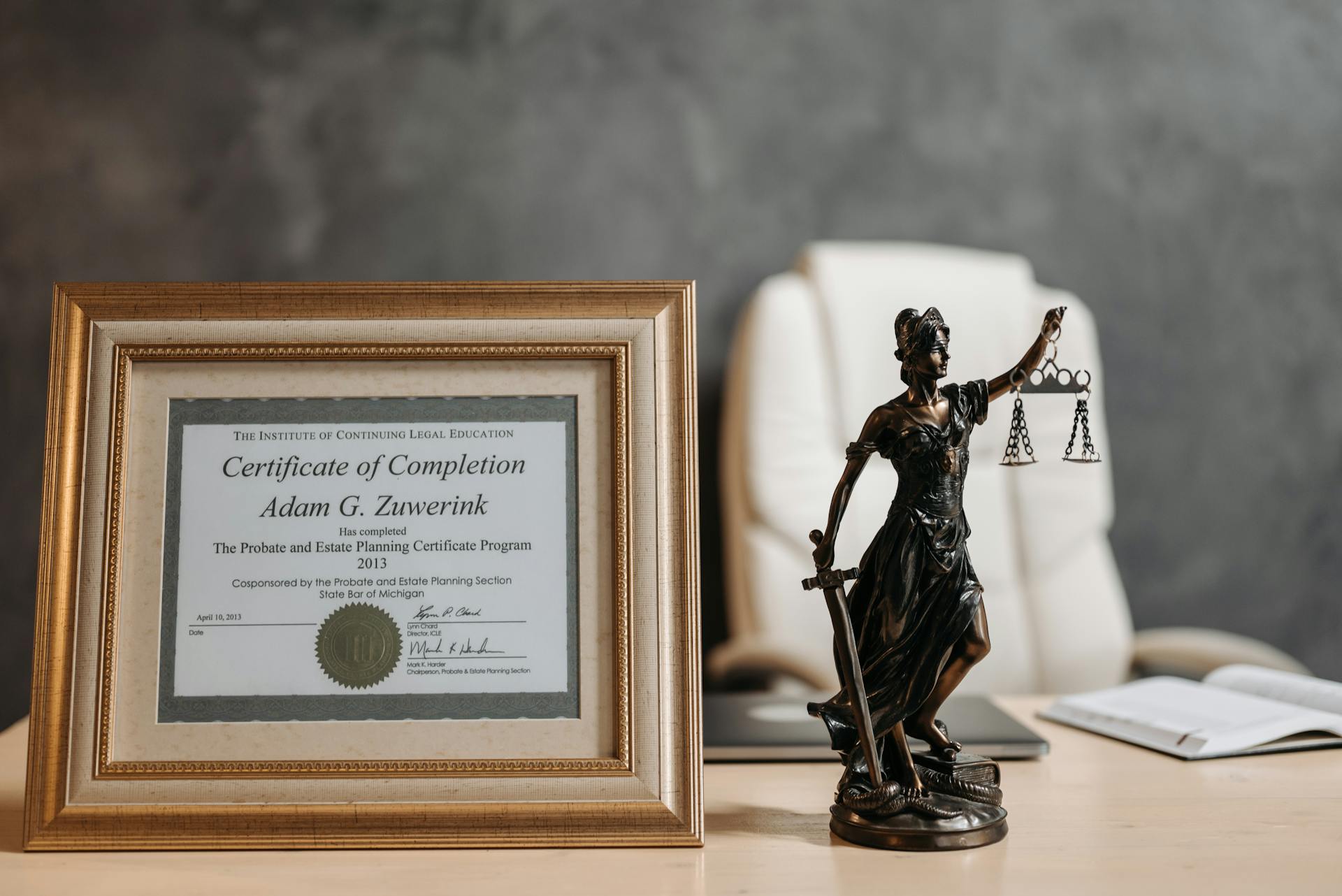
If you're interested in obtaining paper stock certificates, you'll need to start by finding a reputable dealer or broker who can provide you with the necessary documentation.
You can purchase paper stock certificates from a variety of sources, including online brokerages, financial institutions, and stock transfer agents.
Be aware that some companies may not issue paper certificates or may only issue them for large account holders.
To obtain a paper stock certificate, you'll typically need to provide identification and complete a request form.
Take a look at this: Companies That Issue Paper Stock Certificates
What Are Stock Certificates?
A stock certificate is a proof of purchase showing that you own stock in a given company. It's a physical document that verifies your ownership.
Typically, a stock certificate contains the shareholder's name, which is a crucial piece of information. This is a way for the company to confirm who owns the stock.
The date of purchase is also included on the certificate. This is important for tracking when the stock was bought and how long it's been owned.
For your interest: When a Mutual Insurer Becomes a Stock Company

A stock certificate will also show the number of shares owned. This is a straightforward way to display the quantity of stock held.
The type of stock owned is another piece of information that's included on the certificate. This could be common stock, preferred stock, or something else.
A unique CUSIP number is also included on the certificate. This is a special identifier that helps track the purchase.
The signature of the authorized representative of the issuing company is the final piece of information on the certificate. This adds an extra layer of authenticity to the document.
Here's a list of the information typically found on a stock certificate:
- Shareholder’s name
- Date of purchase
- Number of shares owned
- Type of stock owned
- CUSIP (a unique number that identifies the purchase)
- Signature of the authorized representative of the issuing company
Obtaining a Stock Certificate
You can get a physical stock certificate when purchasing stock, but it's not always possible. You may need to contact the transfer agent beforehand to see if they can issue you a certificate after you buy stock through their digital purchasing program.

A transfer agent is a trust company, bank, or financial institution that keeps track of an investor's financial information, such as transactions and securities certificates. They can also help with lost or missing certificates.
If you want a physical stock certificate, you'll need to go through the digital purchasing program and then contact the transfer agent to have your digital record converted into a paper certificate.
For another approach, see: Transfer Brokerage Account to Robinhood
How to Obtain a Certificate via Your Broker
You can obtain a stock certificate through your broker, but be aware that they may charge a fee for the process, which could be tacked on to their own fees.
Ask your broker about the cost upfront, as it can be a significant amount.
Your broker should be able to facilitate the process and deliver the physical certificate to the mailing address you provide.
It's worth noting that obtaining a stock certificate through a broker may not be possible, especially as the financial world continues to shift towards digital platforms.
The issuing company will likely charge a fee for the process, which your broker will then pass on to you.
See what others are reading: Forex Broker Software
Obtaining a Certificate via Transfer Agent

A transfer agent can help you handle the associated fees and guide you through the process. They can also provide you with information on how to obtain a stock certificate.
To get started, you'll need to contact the transfer agent, which can be found through the company's annual report. They will verify your information and issue you a stock certificate.
Here's a brief overview of the steps involved:
- Contact the transfer agent through the company's annual report.
- Verify your information with the transfer agent.
- Request a stock certificate and pay any associated fees.
By following these steps, you can obtain a stock certificate through a transfer agent, even if you're not already holding stock in the company.
Handling and Converting Certificates
If you're an existing shareholder, you can rely on a transfer agent to issue you stock certificates and handle associated fees.
You can ask a transfer agent to issue you a stock certificate even if you're purchasing stock for the first time, but this may not always be possible.
To get a physical stock certificate, you'll need to contact the company beforehand and ask if they can issue one after you buy stock through their digital purchasing program.
Here's an interesting read: Webull Transfer

You may need to go through their digital purchasing program and then contact the transfer agent after the fact to have your digital record converted directly into the paper certificate.
If you have an old stock certificate, you can try to cash it in by using the unique CUSIP number listed on the certificate, but this may not be possible if the company no longer exists or if the stock has already been converted into digital shares.
Can You Still Use Physical Certificates?
Existing shareholders can still use physical stock certificates through a transfer agent, who can issue them and handle associated fees.
You can request a physical stock certificate when purchasing stock by contacting the company beforehand, such as through their transfer agent, and asking if they can issue one after you buy stock through their digital purchasing program.
It may not always be possible to get a physical certificate, even if the company can issue one, and you may need to go through their digital purchasing program first before converting your digital record to a paper certificate.
In some cases, you can get a stock certificate directly from the transfer agent after purchasing stock, but this depends on the company's policies and procedures.
You might enjoy: Stock Quote Southern Company
How to Handle Old Shares
Handling old shares can be a bit of a mystery, but it's definitely worth exploring. You never know what hidden treasures you might uncover.
If the issuing company is still in business, you may be able to cash in your old stock certificate. Your broker can help research this by using the unique CUSIP number listed on the certificate.
You'll need to jump through some hoops, though, especially if your name isn't on the certificate itself. This might involve getting permission from the company or navigating some complex legal procedures.
A transfer agent can help you with this process. They're basically a middleman between you and the company, handling things like keeping track of transactions and issuing new certificates.
However, the process of trading paper stock certificates was often plagued by backlogs and paperwork crises. This could even lead to the New York Stock Exchange shutting down for periods of time.
Discover more: Who Buys Old Stock Certificates

To give you a better idea of the challenges involved, here's a breakdown of some of the complications that came with paper certificates:
The costs of this process were staggering, with the Depository Trust and Clearing Corp. estimating that issuing, recording, storing, and replacing paper certificates cost over $250 million in 2002 alone.
Transition to Electronic Form
The transition to electronic stock certificates was a gradual process that began in the 1970s. Several key events contributed to this shift.
The Depository Trust Company (DTC) replaced the Central Certificate Service in 1973, enabling electronic certificates to exist on a large enough scale to support increasing demand. This was a major step towards electronic stock certificates.
Several laws were introduced in the 1970s that increased investment appetite and brought about a need for a more efficient system. The Employee Retirement Income Security Act (ERISA) introduced individual retirement arrangements (IRAs) in 1974, and the Revenue Act introduced 401ks in 1978.

By the late 1990s, it was clear that paper stock certificates were obsolete. The incremental technology improvements throughout the 70s and 80s allowed more transactions to be processed and automated.
Here's a brief timeline of the key events that contributed to the transition to electronic stock certificates:
- 1973: Depository Trust Company (DTC) replaces the Central Certificate Service.
- 1974: Employee Retirement Income Security Act (ERISA) introduces individual retirement arrangements (IRAs).
- 1978: Revenue Act introduces 401ks.
Buying and Selling Certificates
You can still buy paper stock certificates, but you have to know where to look. Some companies issue them directly to shareholders who request them.
Alternatively, you can reach out to the company directly and provide them with your information to verify your shareholder status. They should be able to issue you a stock certificate based on this information.
Some companies employ a transfer agent to handle their stocks, and you can usually find their contact information on the company's annual report. This agent can help facilitate the process of getting a paper stock certificate.
You can also try buying old stock certificates from collectors, who are willing to pay good money for them. This might be a useful last resort for people who realize their new certificates are for companies that are now worthless.
Old stock certificates can be valuable, with some selling for hundreds or even thousands of dollars. If you're not sure if your certificates are worth anything, you can try researching their value online.
Readers also liked: What to Do with Paper Stock Certificates
Example and History

Paper stock certificates have a rich history that dates back to the 18th century when they were first introduced in the United States.
The first paper stock certificates were issued in 1790, with the first certificate being issued to the Bank of North America. They were made of high-quality paper and featured intricate designs and engravings.
These early certificates were often hand-signed by the company's officers and were considered a valuable commodity. In fact, some of these early certificates are now highly sought after by collectors and can sell for thousands of dollars.
The design of paper stock certificates evolved over time, with the introduction of new printing technologies and techniques. By the mid-19th century, certificates featured elaborate designs and graphics, including vignettes, borders, and even photographs.
Companies like the Bank of North America and the Pennsylvania Railroad were among the first to issue paper stock certificates. These certificates were not only a way for companies to raise capital but also a way to promote their brand and image.
The use of paper stock certificates continued well into the 20th century, with many companies still issuing them today. However, with the advent of electronic trading and digital certificates, the need for paper stock certificates has decreased significantly.
Explore further: Stocks to Trade Paper Trading
Frequently Asked Questions
Are paper stock certificates worth anything?
Yes, old paper stock certificates can have real financial value. Researching and potentially cashing in these certificates can be worth the effort.
What can I do with old paper stock certificates?
Store old paper stock certificates in a safe place until you're ready to trade them, then deposit them into a brokerage account.
What is the best paper stock for certificates?
For certificates, parchment paper is the top choice due to its durability and classic appearance.
How do I cash out a physical stock certificate?
To cash out a physical stock certificate, contact the transfer agent or work with a broker to sell the stock. Research the stock's value beforehand to determine its worth.
Sources
- https://money.stackexchange.com/questions/124898/how-can-i-gift-paper-stock-certificates
- https://www.gorillatrades.com/how-to-get-stock-certificates/
- https://www.kalialawpc.com/2013/06/05/the-demise-of-the-paper-stock-certificate-and-what-it-means-for-companies/
- https://www.teachmepersonalfinance.com/paper-stock-certificates/
- https://www.govmint.com/1876-1897-northern-pacific-rr-paper-stock
Featured Images: pexels.com


